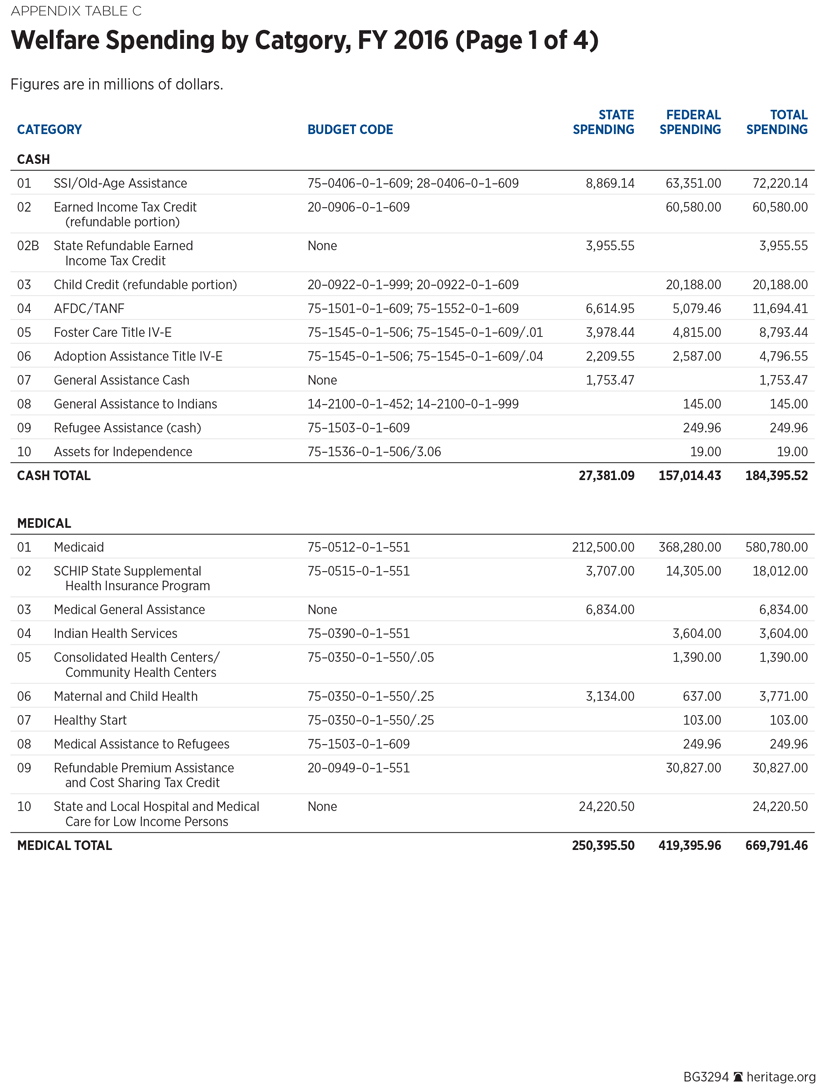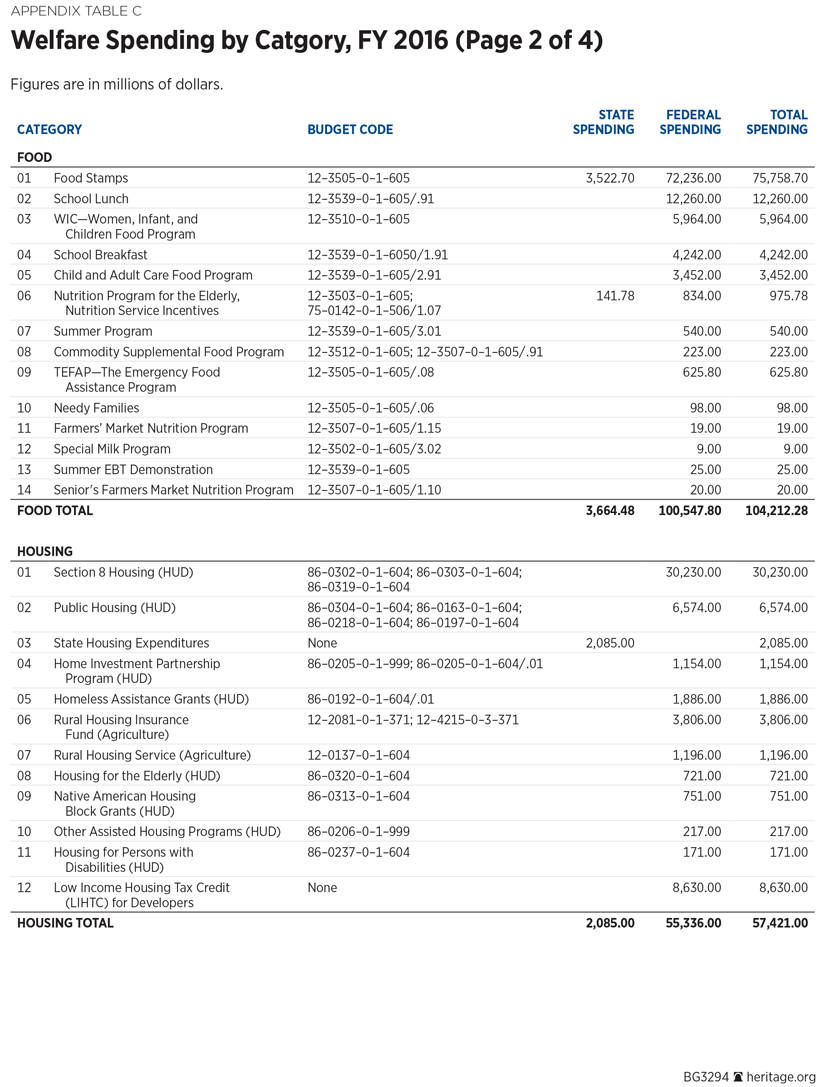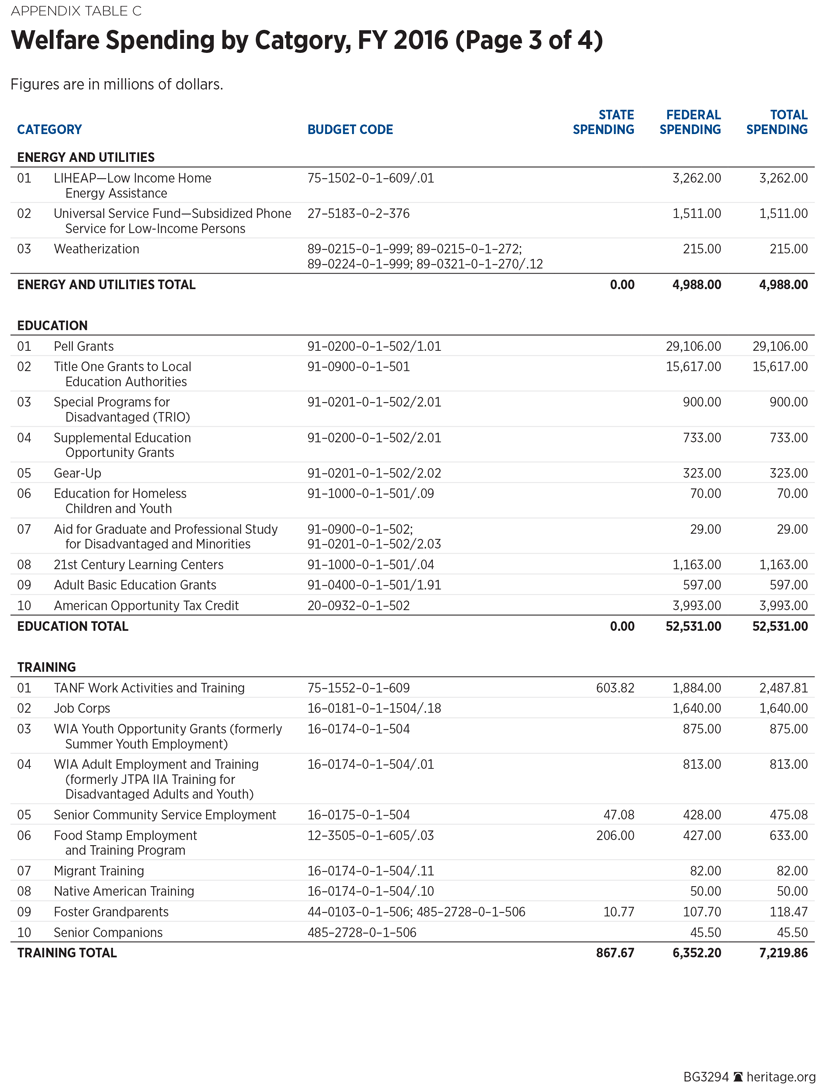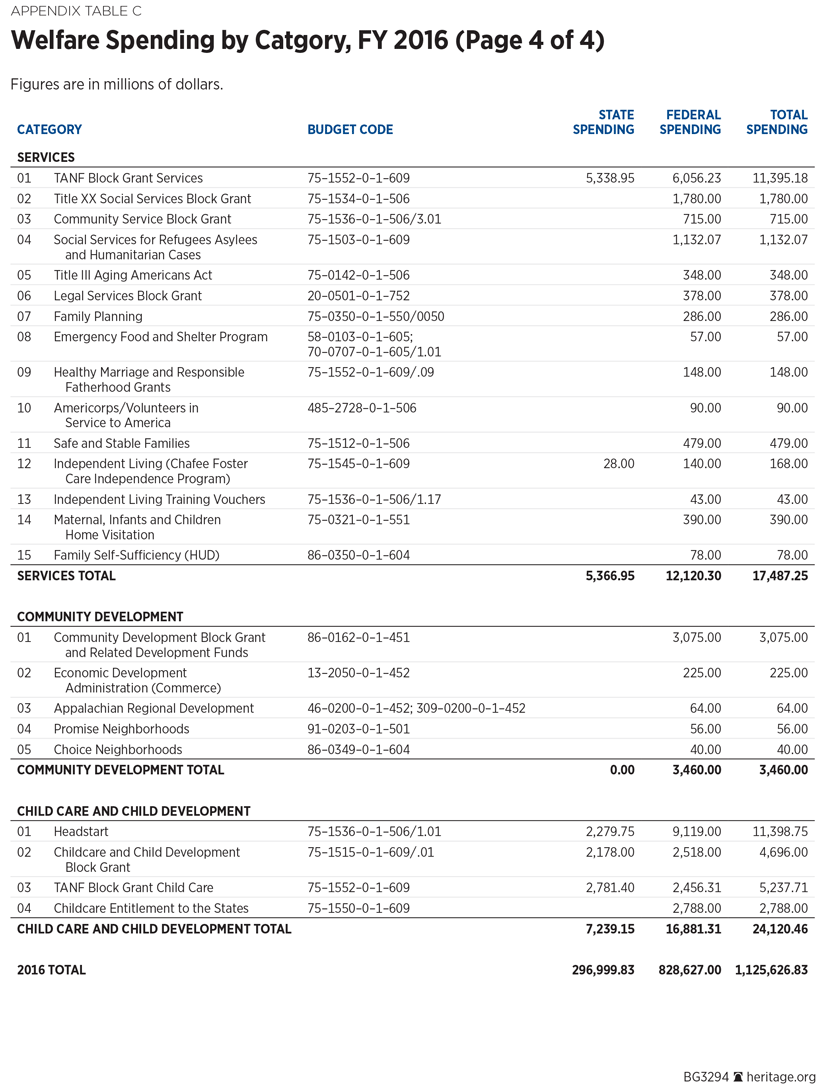Since the beginning of the War on Poverty, government has spent vast sums on welfare or aid to the poor, but the aggregate cost of this assistance is largely unknown because the spending is fragmented into myriad programs.
Whereas Social Security and Medicare appear as two distinct line items in the federal budgetREF and defense spending appears on one line, federal welfare spending is spread across 14 government departments and agencies, nine major budget functions, and 89 separate programs. Spending levels for many programs can be discovered only by data mining the annual 1,300-page budget appendix produced by the Office of Management and Budget (OMB).REF Means-tested welfare also includes billions of dollars in state government contributions to federal welfare programs, and this spending never appears in any federal budget document.
Because of these problems, the large cost of aid to the poor is mostly invisible to the press, decision makers, and the public. In fact, however, welfare or aid to poor and low-income persons is now the third most expensive government function. Its cost ranks below support for the elderly through Social Security and Medicare and below government expenditures on education but above spending on national defense.REF
Only one largely unknown government report totals the cost of means-tested welfare or aid to poor and low-income persons. This report, “Federal Benefits and Services for People with Low Income: Overview of Spending Trends,” is issued irregularly by the Congressional Research Service (CRS). The most recent version was issued in 2016 and covers spending between fiscal year (FY) 2008 and FY 2015.REF Regrettably, CRS reports on aid to poor and low-income persons receive little or no attention.
The programs and spending covered in the current paper are very similar to those covered in the CRS report. The main differences are that the CRS report is limited to federal spending on lower-income persons, while the current paper includes both federal and state spending. The current paper also covers a much longer timeframe, from FY 1950 through FY 2016.
The list of means-tested welfare programs covered here is nearly identical to those included in the CRS reports.REF However, the federal means-tested spending reported by the CRS is somewhat higher than the totals provided in this report. This is largely due to the CRS’s inclusion of some aid programs for veterans in its list. Veterans’ benefits are an earned benefit and therefore not regarded as means-tested aid under the definition employed in the current report.REF The CRS report also includes a few small programs in which the expenditures flow mainly to middle-class rather than poor and lower-income persons; these programs are not included in this Heritage report.REF
For purposes of this report, all federal spending figures have been taken from the annual budget documents prepared by the OMB or departmental budget justifications; other federal government documents were used for early years. State welfare spending levels have been estimated using the state matching rates required by federal law and from data provided in earlier CRS reports or other federal government documents.
What Is Welfare or Aid to the Poor?
Webster’s dictionary defines “welfare” as “aid in the form of money or necessities for those in need.”REF Replacing “those in need” with “those with low income,” we obtain a rough but reasonable definition of government welfare programs: aid in the form of money or necessities for those with low income.
Government welfare programs differ from most other government activities. While most government programs provide benefits and services across all citizens irrespective of economic class, welfare programs provide benefits exclusively to persons with lower incomes. Government welfare programs provide assistance to less-affluent persons that is not available to the general populace because lower-income persons have greater difficulty supporting themselves.
The U.S. welfare system, then, may be defined as the total set of federal and state government programs that are designed specifically to assist poor and low-income Americans. Accordingly, a government program is a “welfare” program if it provides assistance or benefits exclusively and deliberately to poor and low-income persons. (A very small number of programs provide assistance targeted to low-income communities rather than to individuals.)
Whether they are described as “aid to the poor” or as “welfare,” the concept of programs explicitly designed to help less-affluent individuals who have difficulty supporting themselves is clear and distinct.
Means-Tested Aid
Nearly all welfare programs are individually means-tested. Means-tested programs restrict eligibility for benefits and services to persons with non-welfare income below a certain level. Individuals with non-welfare income above the specified cutoff level may not receive aid.REF Thus, food stamps, Temporary Assistance for Needy Families (TANF), and public housing are means-tested aid programs, while Social Security, Medicare, public school education, and police and fire protection are not.
A second, far smaller group of welfare programs are community means-tested. These federal programs target community development and education aid at low-income communities rather than individuals. Community means-tested programs comprise around 2 percent of total means-tested welfare spending.
Means-tested welfare programs serve two purposes. First, they provide various forms of material support, transferring resources to help individuals to obtain goods and services that they cannot purchase on their own. In this respect, means-tested programs provide cash assistance, food assistance, free or subsidized housing, and medical care. Welfare programs may also pay for social services that the poor cannot purchase on their own, such as day care.
The second purpose of welfare programs is to enhance the earning capacity of poor persons or otherwise change behavior in a beneficial direction. Typical of the means-tested programs that serve this purpose are development programs for poor children such as Head Start and job training programs for adults such as Job Corps.REF
Cost of the Means-Tested Welfare System
As noted, for purposes of this paper, the U.S. welfare system is defined as the total set of federal and state means-tested programs that are designed explicitly to assist poor and low-income Americans. The welfare system consists of both individually means-tested programs and a much smaller number of community means-tested programs.
The federal government funds 89 interrelated means-tested programs through four independent agencies (the Federal Communications Commission, Legal Services Corporation, Appalachian Regional Commission, and Corporation for National and Community Service) and 10 Cabinet-level departments (Health and Human Services, Agriculture, Housing and Urban Development, Labor, Treasury, Commerce, Energy, Interior, Education, and Homeland Security). Altogether, these programs provide cash, food, housing, medical care, social services, job training, community development funds, and targeted education aid to low-income persons and communities.REF
State governments also fund welfare. Although some state governments finance small independent welfare programs, most means-tested spending by state governments takes the form of fiscal contributions (matching funds) to federal welfare programs. State matching funds are an important adjunct of the federal welfare system. Since state governments contribute fiscally to and in many cases actually administer federal welfare programs, it is necessary to examine federal and state spending and operations together in order to understand the size and scope of the overall welfare system.
Federal and State Welfare Spending
The federal government has played the predominant role in designing and financing government-provided welfare since the 1930s. Of the more than $1.1 trillion spent in FY 2016, federal expenditures accounted for $829 billion (74 percent), and state expenditures accounted for $297 billion (26 percent). Most state spending ($213 billion) occurs in a single program: Medicaid. If Medicaid is excluded from the spending count, about 85 percent of the remaining means-tested expenditures comes from federal funds.
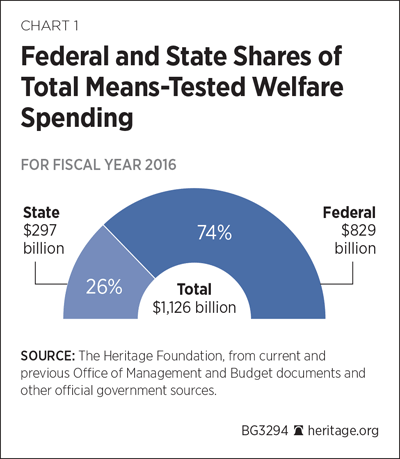
Types of Assistance
The means-tested welfare system provides nine different categories of assistance to poor and low-income persons: cash, food, housing, medical care, social services, child development and child care, jobs and job training, community development, and targeted federal education programs. In each category of assistance, government provides assistance to poor and lower-income persons that it does not provide to the general population.
Combined federal and state spending levels for each category of assistance in FY 2016 were as follows:
The most prominent tax credit is the EITC, which has both refundable and non-refundable components. For purposes of this paper, only the refundable portions of the EITC and other tax credits are defined as welfare aid and counted in the spending totals.
-
Medical assistance. This type of means-tested assistance cost taxpayers $669.8 billion in FY 2016 and comprised 59.5 percent of total means-tested aid. Major means-tested medical programs included Medicaid, the Children’s Health Insurance Program (CHIP), the Maternal and Child Health Block Grant, and refundable premium assistance and the cost sharing tax credit under the Affordable Care Act.
-
Cash aid. This type of means-tested assistance cost taxpayers $184.4 billion in FY 2016 and comprised 16.4 percent of total means-tested aid. Major means-tested cash programs include TANF cash grants; Supplemental Security Income (SSI); the Earned Income Tax Credit (EITC); and the Additional Child Tax Credit (ACTC).
Refundable tax credits are an increasingly important type of means-tested cash aid. With a refundable credit, government gives a cash grant to a low-income family that owes no income tax. Some like to argue that both refundable and non-refundable tax credits should be regarded as tax relief, but the two differ fundamentally. A normal non-refundable tax credit allows a family to keep more of the income it has earned by reducing the taxes it pays to government. By contrast, with a refundable tax credit, one family is taxed, and the money is transferred in the form of a cash grant to another family that has not earned it. A refundable credit is a classic example of means-tested welfare aid.
-
Food aid. This type of means-tested assistance cost taxpayers $104.2 billion in FY 2016 and comprised 9.3 percent of total means-tested aid. Major means-tested food assistance programs include food stamps; the Women, Infants, and Children (WIC) food program; the school lunch and breakfast programs for children under 185 percent of poverty; and The Emergency Food Assistance Program (TEFAP).
-
Housing, energy, and utilities assistance. This type of means-tested assistance cost taxpayers $62.4 billion in FY 2016 and comprised 5.5 percent of total means-tested aid. Major means-tested housing and energy programs include public housing, Section 8 housing, and the Low Income Home Energy Assistance Program (LIHEAP).
-
Child development and child care. This type of means-tested assistance cost taxpayers at least $24.1 billion in FY 2016 and comprised 2.1 percent of total means-tested aid. Major means-tested child development programs include Head Start and the Child Care and Development Block Grant (CCDBG).REF
-
Social services. This type of means-tested assistance cost taxpayers $17.5 billion in FY 2016 and comprised 1.6 percent of means-tested aid. Major programs that fund social services include the Social Services Block Grant (SSBG); TANF; and the Community Services Block Grant (CSBG).
-
Jobs and job training. This type of means-tested assistance cost taxpayers $7.2 billion in FY 2016 and comprised 0.6 percent of total means-tested aid. Major means-tested programs that provide funding for training include the Workforce Investment Act (WIA) program for adults, Workforce Investment Act Opportunity Grants for Youth, TANF, and the Job Corps.
-
Community development. This type of community means-tested assistance cost taxpayers $3.5 billion in FY 2016 and comprised 0.3 percent of total means-tested aid. Most means-tested community development spending occurs through the Community Development Block Grant (CDBG). The goal of this spending is to assist low-income communities that are having difficulty raising tax revenues on their own and to increase employment opportunities in poor communities by improving public infrastructure.
-
Targeted education spending for low-income persons and communities. This type of assistance cost taxpayers $52.5 billion in FY 2016 and comprised 4.7 percent of total means-tested spending. Major programs include Pell Grants for low-income individuals and Title I education grants targeted to low-income communities.
These figures are summarized in Chart 2. A list of amounts spent in each of the 89 federal means-tested programs and three independent state spending categories is provided in Appendix C.
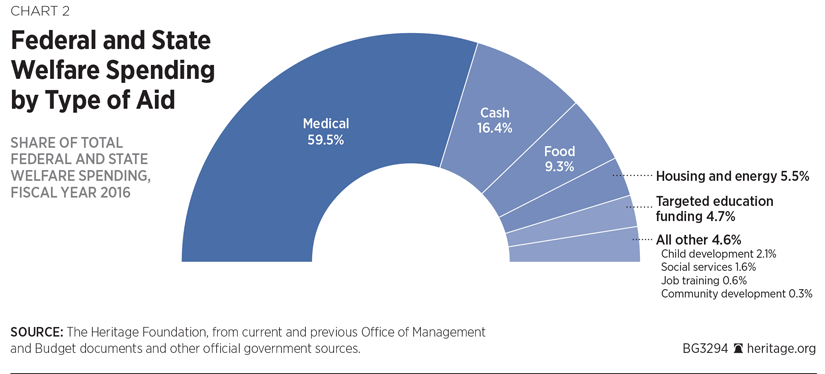
As Chart 2 shows, while means-tested programs are diverse, the bulk of spending occurs in four categories: cash, food, housing, and medical care. In FY 2016, medical care absorbed almost 60 percent of total means-tested spending, while cash, food, and housing comprised 31 percent. Cash, food, housing, and medical care together comprised over nine-tenths of total welfare costs.
The goal of these four types of programs is to raise the economic and material conditions of lower-income persons by providing them with goods and services that they ostensibly cannot earn or purchase with their own resources. These programs are intended to redistribute income: Upper-income families are taxed, and economic resources are transferred to raise the living standards of the less affluent.
The remaining five means-tested spending categories (job training, social services, child development and child care, targeted education, and community development) take up only 9.3 percent of total means-tested spending. These programs have a greater emphasis on capacity building and behavior change among the poor. They seek to increase ability and reduce the behavioral problems that lead to poverty and dependence. For example, child development, targeted education, and job training programs seek to raise the cognitive and vocational skills of less advantaged persons and thereby increase their earnings and capacity for self-support. Community development programs have a goal of increasing employment opportunities in low-income communities through public infrastructure spending.REF
Recipients of Welfare Spending
Chart 3 breaks out welfare spending by type of recipient in FY 2015, the most recent year for which these data were available. Total welfare spending in FY 2015 equaled $1.08 trillion. Families with children received $545.9 billion in welfare aid, roughly half (50.5 percent) of the total. The other roughly half went to households without children. Of this, $308.4 billion (28.5 percent) went to disabled adults; $129.9 billion (12 percent) went to the elderly; and $97.8 billion (9.0 percent) went to able-bodied adults who were neither parents nor elderly.
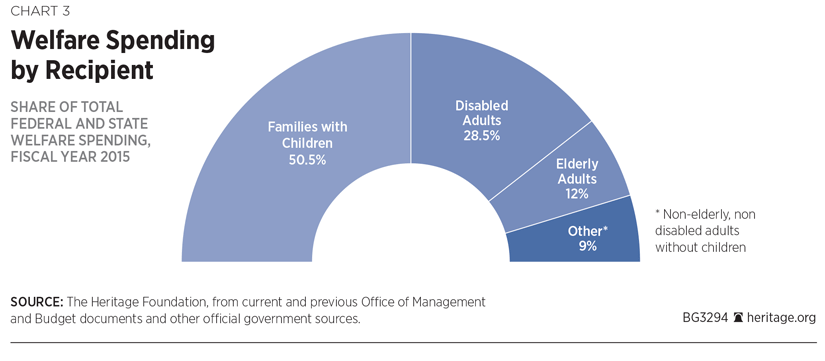
Long-Term Growth of Welfare Spending
Means-tested welfare spending has grown rapidly since Lyndon Johnson launched the War on Poverty in 1964. In that year, federal and state means-tested spending was $10.6 billion. By 2016, it had risen over a hundredfold to $1.1 trillion.
Obviously much of this increase was due to inflation. Adjusted for inflation, welfare spending in 1964 was $91.9 billion in constant 2016 dollars.REF Thus, even with inflation adjustment, total means-tested welfare spending has increased more than twelvefold since the start of the War on Poverty, rising from $91.9 billion in 1964 to over $1.1 trillion in 2016.
Some might argue that much of this increase was due to growth in the population, but the U.S. population grew by only 66 percent during this period. Total inflation-adjusted welfare spending per person increased more than sevenfold over the period, rising from $478 per person in 1964 to $3,522 per person in 2016.REF
Means-tested expenditures on medical care showed the greatest increase over this period. In 1964, governmental medical assistance to the poor was very limited: only about $50 billion per year in today’s dollars. Adjusted specifically for the rise in medical prices, means-tested medical spending increased more than thirteenfold over this period. By the end of 2015, over 82.5 million low-income persons were receiving care under Medicaid and other means-tested medical programs at a cost of approximately $645.8 billion per year.REF
Other welfare spending also grew rapidly. After adjusting for inflation, means-tested spending on cash, food, and housing programs rose nearly tenfold over the period, from $36.4 billion in 1964 to $351 billion in 2016. In constant 2016 dollars, per-person spending on cash, food, and housing rose nearly sixfold from $190 in 1964 to $1,098 per person in 2016.REF
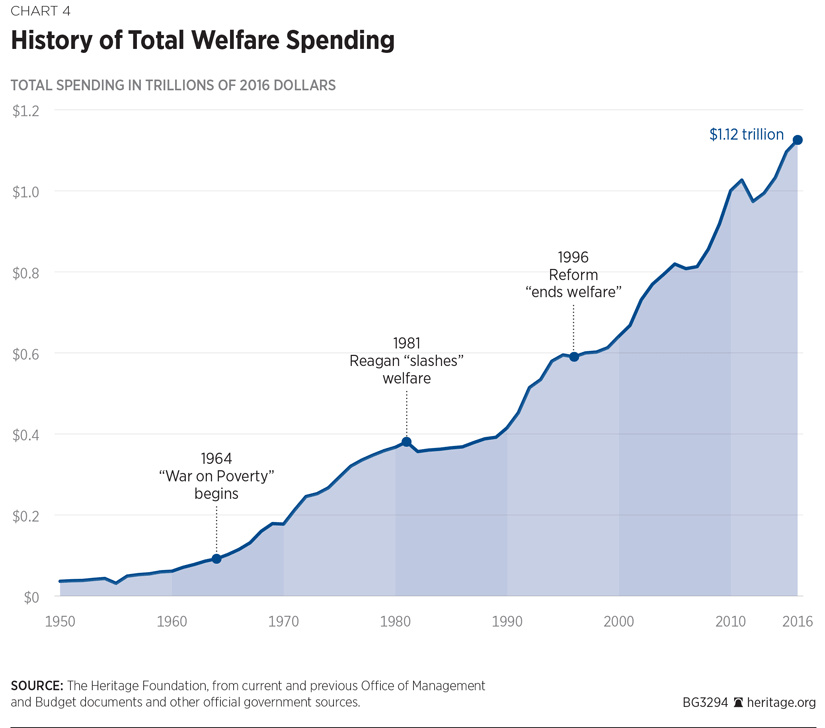
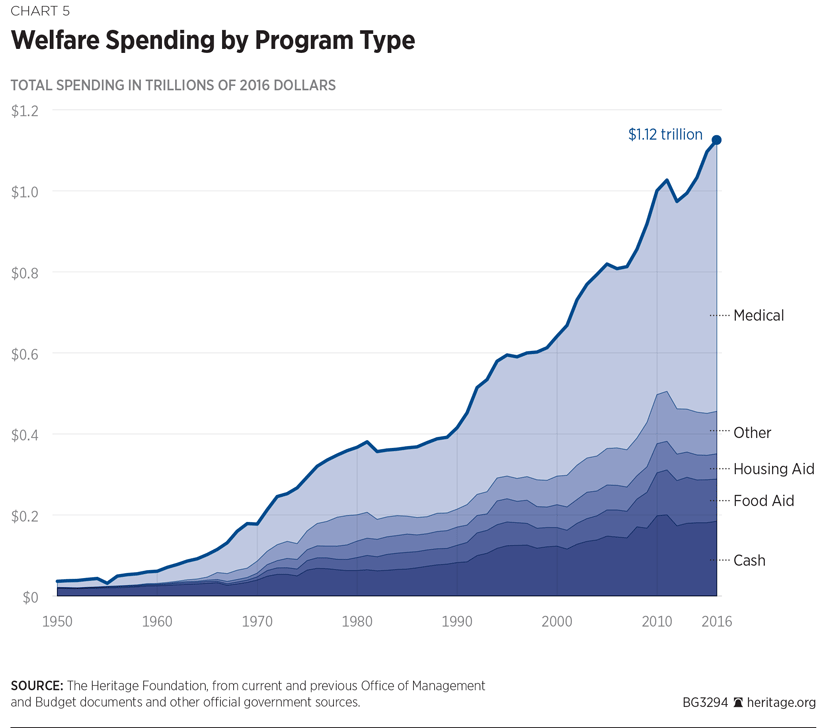
Conventional wisdom holds that welfare spending resembles a roller coaster, rising during recessions and declining during periods of economic growth. However, Chart 4 and Chart 5 show that welfare spending more closely resembles a mountain slope. Spending rises rapidly in some years and less rapidly in others, but the overall trend is steadily upward. In the over five decades since the beginning of the War on Poverty, inflation-adjusted welfare spending has increased in 47 years and declined in only five.
Welfare Spending as a Share of GDP
Means-tested welfare has grown not only in absolute terms, but also as a share of the total U.S. economy. Chart 6 shows annual welfare spending as a percentage of gross domestic product (GDP) over the past half-century.
At the end of World War II, means-tested government welfare stood at 0.6 percent of GDP. Two decades later, in 1964, as Lyndon Johnson inaugurated the War on Poverty, spending was only slightly higher at 1.5 percent of GDP.REF Over the next decade and a half, spending exploded, reaching around 3.7 percent of GDP by the late 1970s. Spending remained relatively flat during the Reagan era of the 1980s, averaging 3.6 percent of GDP. After Ronald Reagan left office, spending began to climb rapidly again.
Although there was much ado about “ending welfare as we know it” in the 1990s, the welfare reform enacted in 1996 resulted in only a slight pause in spending growth. By 2016, means-tested welfare had risen to over 6 percent of GDP. Since the 1980s, means-tested spending as a share of GDP has increased between one-half of a percentage point and a full percentage point on average per decade. All indications are that it will remain around 6 percent of GDP in the coming decade.
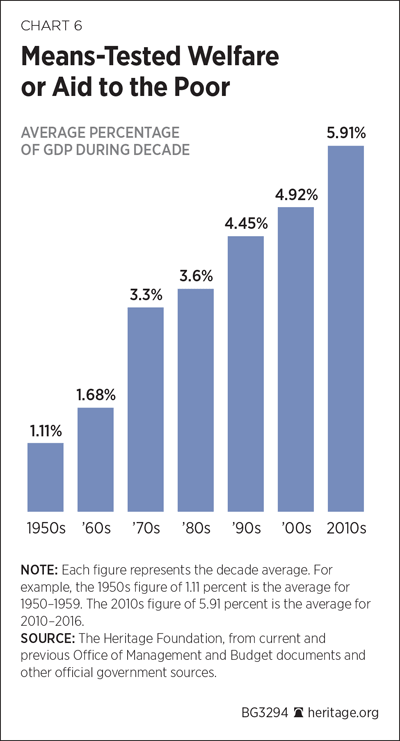
Total Cost of the War on Poverty
The financial cost of the War on Poverty has been enormous. Between 1965 and 2016, total means-tested welfare spending by federal and state governments cost taxpayers roughly $27.8 trillion in constant FY 2016 dollars. By contrast, the cost to the U.S. government for all military wars from the American Revolution to the present is $8 trillion in FY 2016 dollars.REF
In other words, the War on Poverty has cost the taxpayers nearly three and a half times the combined cost of all military wars in U.S. history. The most expensive military war in U.S. history was World War II, but its cost was only $4.3 trillion in FY 2016 dollars: about one-sixth of the ongoing cost of the War on Poverty.
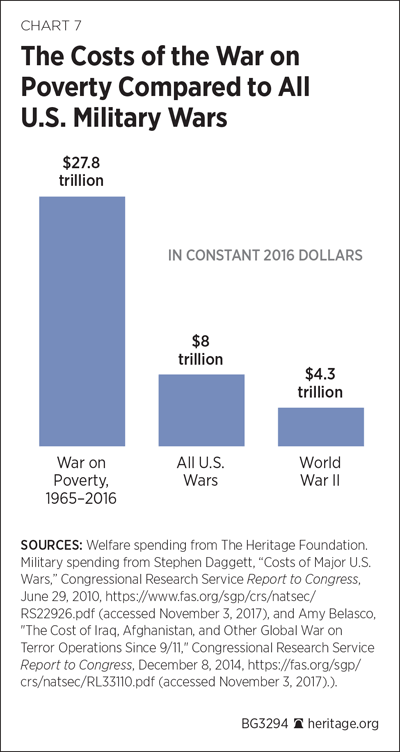
Means-Tested Welfare and the Poverty Gap
The pre-welfare poverty gap equals the amount of money needed to raise the income of all currently poor households up to the federal poverty level ($24,339 for a family of four with two children in FY 2016). To calculate the pre-welfare poverty gap for each household, the poor household’s non-welfare cash income is counted and compared to the poverty income threshold for a family of that size. The difference between the poor family’s non-welfare income and the appropriate poverty threshold equals the pre-welfare poverty gap for that family.
According to Census figures, the aggregate pre-welfare poverty gap in 2016 was roughly $248 billion.REF In 2016, means-tested welfare spending on cash, food, and housing in that year came to $351 billion. Thus, means-tested welfare spending on cash, food, and housing programs was roughly 1.4 times the amount needed to raise every poor person’s income above the poverty level.
Adding medical spending to that amount brings the total to $1.02 trillion in that year: over four times the pre-welfare poverty gap for 2016. Thus, if means-tested welfare spending were simply converted into cash, the sum would be over four times the amount needed to eliminate poverty by raising the income of each poor family above the official poverty income thresholds.
Means-Tested Welfare for Families with Children
Approximately 50 percent of means-tested welfare spending goes to low-income families with children. Cash, food, and housing spending alone on those families in 2015 came to $219 billion. When medical care is added, the total comes to $449 billion.REF
In 2015, the pre-welfare poverty gap for families with children was $76.7 billion. In other words, it would take $76.7 billion to raise the income of every poor family with children up to the poverty level. At $219 billion, means-tested cash, food, and housing spending was nearly three times the amount needed to eliminate all poverty among families with children. At $449 billion, cash, food, housing, and medical spending was nearly six times the amount needed to eliminate all poverty among children.
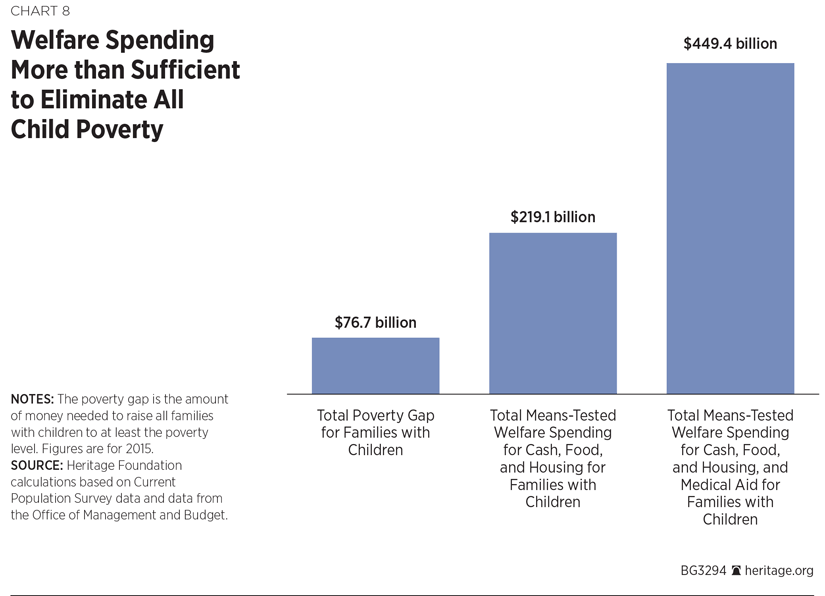
Most Means-Tested Welfare Ignored in Measurements of Poverty and Inequality
Readers may reasonably ask how government can spend so much on welfare while so many people still apparently live in poverty. For example, the U.S. Census Bureau informs us that in 2016, there were roughly 12.8 million children in America living in poverty.REF How can government spend these enormous sums and still have 12.8 million children in poverty?
One common response to this question is that the welfare state is large and poverty is high because federal and state bureaucracies absorb most welfare spending, and very little reaches the poor. This is untrue. On average, administrative costs are less than 10 percent of means-tested cash, food, housing, and medical spending.REF More than 90 percent of this spending reaches low-income families as benefits.
In reality, nearly all welfare spending reaches poor and low-income persons as tangible benefits and services. The government continues to report millions living in poverty in large measure because of substantial flaws in the techniques the government uses to measure income and poverty.
The U.S. Census Bureau identifies a household as poor if its income falls below the specified federal poverty level. Yet in counting a family’s income, the Census Bureau ignores nearly all means-tested welfare. In particular, food stamps and other food aid, housing subsidies, health care benefits, the EITC, and other refundable credits are not counted as income. Of the $449 billion spent on cash, food, housing, and medical care for families with children in 2016, the Census Bureau counted only $14.7 billion (3.3 percent) as “income” for purposes of measuring child poverty.REF When calculating official poverty statistics for the entire population, the Census Bureau counted only around $56.5 billion (5 percent) of a total of over $1.1 trillion in means-tested expenditures as income.
Similarly, the Census measures income equality each year. U.S. households are ranked by income and then divided into fifths or quintiles. The share of income received by each fifth is determined. Yet in measuring income for this purpose, the Census again ignores almost the entire welfare state. Means-tested welfare has risen from 1.5 percent of GDP in 1964 to over 6 percent today. Nearly all of this spending assists persons in the lowest two quintiles, but when measuring economic inequality, almost none of this transfer is computed. When welfare received by the poor and taxes paid by the rich are included in the assessment, inequality in the U.S. is far less than conventional Census figures suggest.REF
The welfare state is expensive not because bureaucracy swallows the funds but because the welfare system provides very generous benefits to tens of millions of families. However, the real problem in welfare is neither an accounting issue (how poverty is measured) nor bureaucratic inefficiency but the “moral hazard” of existing welfare programs’ tendency to discourage self-support through work and marriage.
Welfare Benefits Much Higher Than Most Imagine
A second, related misconception is that the amount of welfare benefits that households receive is meager. Since the welfare system is much larger than most imagine, so too are the benefits that households receive.REF
Consider a single mother who has two school-age children and has worked full-time for 52 weeks in the year at the federal minimum wage of $7.25 per hour.REF (The overwhelming majority of single parents actually work at a higher wage rate.) This mother would receive $13,853 in annual post-tax earnings.REF Based on earnings alone, her income is well below the official FY 2015 poverty income threshold of $19,096 for a family of three.REF
But this mother would also be eligible for basic means-tested benefits including Earned Income Tax Credit, Additional Child Tax Credit, food stamp, school lunch, and (in some cases) school breakfast benefits. As Chart 2 shows, in addition to $13,853 in post-tax earnings, the mother would receive $5,548 in cash benefits through the EITC and $1,800 in cash benefits through the ACTC. The family would also get $3,974 in food stamp benefits and $1,269 in school lunch and school breakfast benefits. The combined value of earnings, cash welfare, and food benefits would come to $26,444: nearly 40 percent above the official poverty level. Counting both earnings and benefits, the effective hourly wage rate would be $12.71 per hour.
The objective that a low-wage parent who works full-time for the whole year should be able to support a family above the poverty level when earnings and welfare are combined is laudable.REF In most respects, the existing welfare system already fulfills that objective if existing benefits are counted accurately.REF Unfortunately, most discussions of welfare ignore the standard benefits shown in Chart 9; the taxpayers get no credit for the generous support they provide. More important, most existing welfare programs either fail to encourage or actively discourage efforts toward self-support through work and marriage. As a result, they are inefficient, unnecessarily costly, and ultimately harmful to recipients.
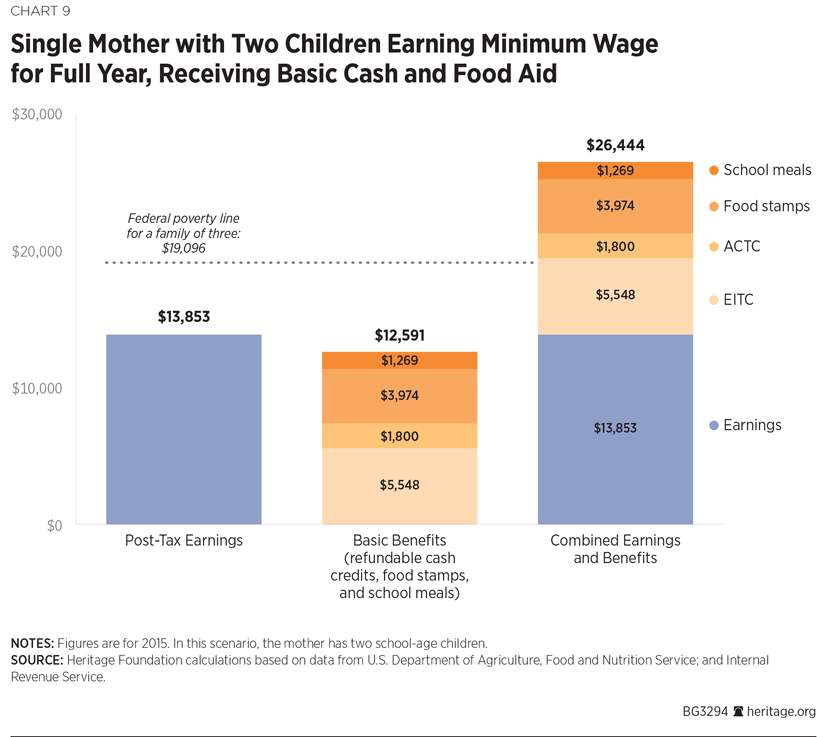
Adding Medical Benefits. In a Medicaid non-expansion state, both of our hypothetical mother’s children would be eligible for Medicaid. The average cost to the taxpayer of the medical benefits provided per child would be $2,807.REF On average, the combined cost of the two children would be $5,614. When post-tax earnings of the minimum-wage worker, cash welfare, food aid, and medical benefits are combined, the sum would be $32,057. The effective wage rate for benefits and wages combined would be about $15.40 per hour.
In a Medicaid expansion state, both the children and the parent would be eligible for Medicaid. The average cost to the taxpayer of the medical benefits provided to the parent would be $4,391. The combined average benefits for a parent and two children would be $10,005.
As Chart 10 shows, when post-tax earnings of the minimum-wage worker, cash welfare, food aid, and medical benefits for the children and parent are combined, the sum would be $36,449, which is nearly twice the official poverty level for the family. The effective wage rate would be more than $17.50 per hour.REF
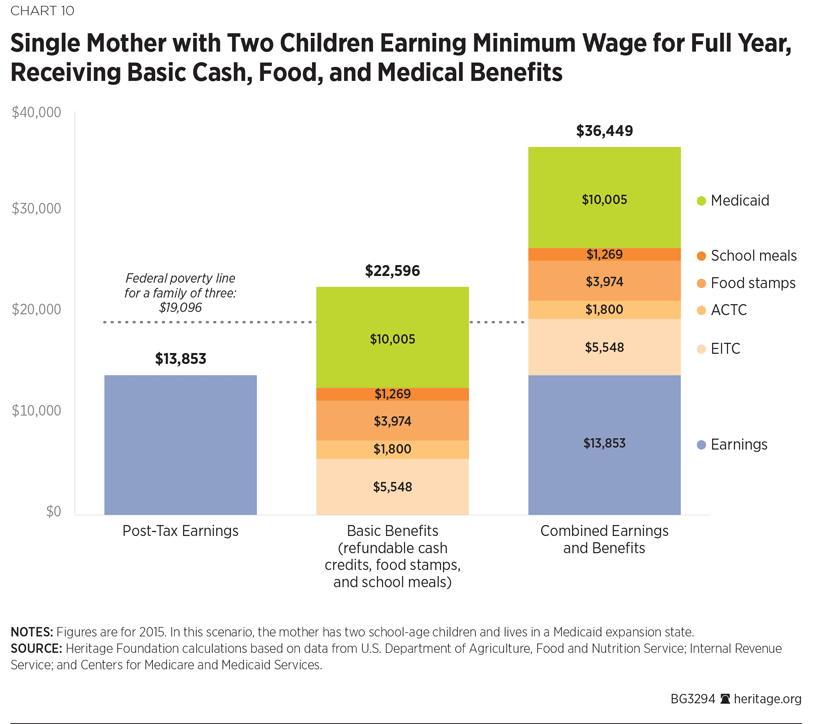
Single-Parent Families with Housing Benefits. The welfare benefits included in Chart 10 represent the basic welfare package in the U.S. As noted, nearly all low-wage working parents with school-age children will receive benefits from the six programs described above.REF
However, many low-income families with children receive other benefits in addition to the basic package. The most important of these are rent subsidies provided by the U.S. Department of Housing and Urban Development (HUD). In 2015, some 1.6 million single-parent families received HUD rent subsidies.REF This represents about one-quarter of poor and near-poor single parents.REF
The most common type of subsidized housing is Section 8 benefits, which generally are distributed as vouchers. When Section 8 housing or other subsidized housing is added to the basic benefit package, the overall benefit stack becomes quite high. As Chart 11 shows, the combined earnings and benefits could reach $47,385 per year.REF The effective hourly wage rate is $22.78 per hour.
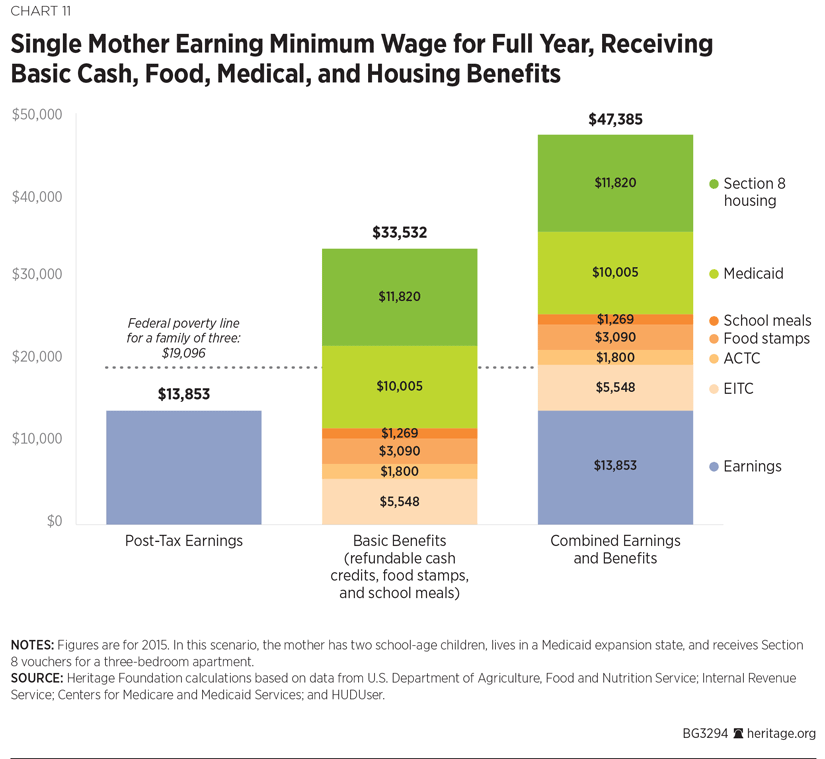
The War on Poverty in Historical Context
When Lyndon Johnson launched the War on Poverty, he declared that it would strike “at the causes, not just the consequences of poverty.”REF He added, “Our aim is not only to relieve the symptoms of poverty, but to cure it and, above all, to prevent it.”REF
Thus, President Johnson was not proposing a massive system of ever-increasing welfare handouts distributed to an ever-enlarging population of beneficiaries. Instead, he was seeking to increase prosperous self-sufficiency among the poor. His ostensible goal was not a massive new government dole system, but an increase in self-sufficiency: a new generation capable of supporting themselves out of poverty without government handouts.
The U.S. has spent $27.8 trillion on welfare since President Johnson launched the War on Poverty. Over time, the material living conditions of the poor have improved. It would be impossible to spend nearly $28 trillion without any positive impact on living conditions, but in terms of reducing the causes rather than the consequences of poverty, the War on Poverty has failed utterly. The situation has gotten worse. A significant portion of the population is now less capable of prosperous self-sufficiency than it was when the War on Poverty began.
A major element in the declining capacity for self-support is the collapse of marriage in low-income communities. As the War on Poverty expanded benefits, welfare began to serve as a substitute for a husband in the home, and low-income marriage began to disappear. When Johnson launched the War on Poverty, 7 percent of American children were born out of wedlock. As of 2015, the number was over 40 percent. As husbands left the home, the need for more welfare to support single mothers increased. The War on Poverty created a destructive feedback loop: Welfare promoted the decline of marriage, thereby generating a need for more welfare.
Today, unwed childbearing, with its consequent growth of single-parent homes, is the single most important cause of child poverty. (Unwed childbearing is not the same thing as teen pregnancy. The overwhelming majority of non-marital births occur to young adult women in their early twenties, not to teenagers in high school.) If poor women who give birth outside of marriage were married to the fathers of their children, two-thirds would immediately be lifted out of poverty.REF Approximately 80 percent of all long-term child poverty occurs in single-parent homes.REF
Despite the dominant role of the decline of marriage in child poverty, the issue is taboo in most anti-poverty discussions. Far from seeking to reduce the main cause of child poverty, the welfare state cannot even acknowledge its existence.
The second major cause of child poverty is lack of parental work. Even in good economic times, the average poor family with children has only 800 hours of parental work per year. This is the equivalent of one adult working 16 hours per week. The math is fairly simple: Little work equals little income, which equals poverty. If the amount of work performed in poor families with children were increased to the equivalent of one adult working full-time through the year, the poverty rate among these families would drop by two-thirds.REF
Welfare reform in the mid-1990s focused attention, albeit very briefly, on work. Federal work requirements were established in the Temporary Assistance for Needy Families program, which replaced the old Aid to Families with Dependent Children (AFDC) program. The new rules required a portion of able-bodied TANF recipients to work or prepare for work and strongly encouraged a decrease in welfare caseloads. In response, caseloads plummeted, employment of single mothers surged, and child poverty dropped substantially for the first time in decades.REF The growth of overall welfare spending slowed a bit.
However, welfare reform was always more limited than is generally understood. Work requirements were established in only one of what are now 89 means-tested programs, and even in the TANF program, many recipients were unaffected. Moreover, due to technicalities in the construction of the law, the federal work standards that had driven the caseload reduction lost force by around 2000. In the absence of external pressure, most state welfare bureaucracies lapsed into their traditional role as check-writing agencies. In the average state today, over half of adult TANF recipients are not engaged in any work or work preparation activities at all.REF Always limited, welfare reform is itself in major need of reform today.
The War on Poverty has become detached from reality. Current political discourse refuses to recognize or even mention the principal causes of poverty: the lack of work and the decline of marriage.REF To acknowledge those issues would be to “blame the victim.” Instead, political correctness insists that the principal cause of poverty is the unwillingness of taxpayers to increase welfare and education spending. Despite massive increases in government spending in these fields for decades, no sum is ever enough. Spending must always be increased with no end in sight.
The original goal of the War on Poverty, as stated by President Johnson, was to reduce both poverty and dependence on government. That goal has now been abandoned. The new goal is simply to “spread the wealth” for its own sake. The mechanism for accomplishing this is a substantial ongoing expansion of means-tested welfare.
To spread the wealth, the array of welfare benefits and the number of recipients must steadily increase, and welfare as a share of the economy must rise. Occasionally, lip service will still be paid to reducing government dependence, but, ironically, this concept almost always appears as a justification for new government spending. The War on Poverty, rife with perverse incentives, has become a system of permanent income redistribution that is likely to expand indefinitely.
Reforming the Welfare System
Debates about welfare in the U.S. often degenerate into a tug of war in which the left simply seeks to expand conventional welfare spending while the right seeks to shrink it. It is true that the welfare system is far larger and costlier than the public imagines. It contains substantial waste and fraud that should be eliminated. However, the most important problem in welfare is not its considerable cost to the taxpayers but its harmful effects on the poor themselves.
Real welfare reform must involve dramatically altering the character of welfare programs and the manner in which those programs interact with the behavior of the poor. The framework of reform can be clarified by examining three separate but interrelated concepts: income or financial poverty, behavioral poverty, and psychological well-being.
Income Poverty. Poverty and welfare are typically analyzed in simple financial terms. Poverty means having an income below certain thresholds.REF Increases in welfare benefits are urged to raise income. However, income poverty can be split into two separate concepts: income poverty before receipt of welfare benefits and income poverty after receipt of welfare benefits.
Income poverty before receipt of welfare benefits means that a family has an income below the poverty income thresholds before any welfare benefits received by the family are counted. This concept is closely linked to self-sufficiency, the ability of a family to maintain an income above the poverty level without reliance on welfare aid. A family that lacks self-sufficiency by definition experiences “income poverty before receipt of welfare benefits.”
By contrast, income poverty after receipt of welfare benefits counts the welfare benefits that are added to a family’s earnings when determining poverty. These benefits include cash aid such as the Earned Income Tax Credit, the Additional Child Tax Credit, Supplemental Security Income, and Temporary Assistance to Needy Families; food benefits such as food stamps and the Women, Infants, and Children food program; and housing aid such as public housing subsidies and Section 8 vouchers. (Medical benefits such as Medicaid, Children’s Health Insurance Program (CHIP), and Obamacare subsidies boost living standards but would generally not be included in poverty measurement.) A great many low-income families receive benefits from overlapping welfare programs, and these benefits can raise family incomes substantially. As a consequence, there is a considerable difference between poverty rates before receipt of welfare and after receipt of welfare.
Debates about poverty are generally confused because of the ambiguity of the Census Bureau’s annual poverty report.REF The official Census poverty report is represented and almost universally understood as a report on income poverty after receipt of welfare benefits. This is incorrect because, as noted previously, the official Census poverty report actually excludes nearly the entire welfare state from its measurement of poverty. In general, counting means-tested cash, food, and housing aid as income would cut the income poverty rate in the U.S. in half. Ironically, because it excludes nearly the entire welfare state, the Census Bureau’s official poverty measure is a fairly accurate measure of income poverty before receipt of welfare benefits, or lack of self-sufficiency.
On the surface, the simplest goal of welfare would be to reduce poverty by raising incomes; however, this goal can be pursued by two contradictory approaches depending on whether the focus is on pre–welfare income or post–welfare income poverty. On one hand, government can simply guarantee welfare benefits at higher and higher levels. On the other hand, government can promote self-sufficiency: the ability of individuals to support their families above the poverty level through their own efforts without the need for welfare aid.
The principal mechanisms of prosperous self-sufficiency are work, earnings, and marriage. A conservative approach to welfare would seek to strengthen, not undermine, these mechanisms.
Behavioral Poverty (Self-defeating and Self-limiting Behaviors). Although most public debate about poverty simply involves income poverty, the related concept of behavioral poverty is actually more important. Behavioral poverty consists of self-defeating and self-limiting behaviors. It may be defined as a set of eight behavioral outcomes or conditions. Behavioral poverty outcomes are strong causal factors contributing to pre–welfare income poverty (or lack of self-sufficiency) as well as reduced psychological well-being. The eight elements of behavioral poverty are:
-
Lack of marriage, unstable sexual relationships, sequential cohabitation, and high levels of single parenthood;REF
-
Persistent unemployment, underemployment, or detachment from the labor force influenced by impaired work attitudes, an element that is especially important among healthy young men;
-
Low levels of basic verbal and math skills, low academic achievement; and failure to complete high school;
-
Drug and alcohol abuse and dependence;
-
Criminal activity, especially violent crime;
-
Traditional welfare dependence;REF
-
Limiting and harmful home environments and the transmission of self-limiting norms and behaviors to children within the home; and
-
Negative community effects: low levels of social capital, high levels of social isolation and anomie, harmful peer relationships, and lack of attachment to value-generating institutions such as churches.
Behavioral poverty traits are dysfunctional in the sense that they make it substantially more difficult for individuals to succeed in mainstream society. By contrast, the absence of these self-defeating and self-limiting behaviors contributes to positive life outcomes, helping individuals to escape from income poverty and improve psychological well-being.
The first five behavioral poverty conditions are the strongest factors. Fortunately, few individuals will exhibit all five. The presence of any one of the first five conditions will create difficulties in life, but the individual may well persevere against challenges because the absence of the remaining four can create a positive bulwark that buffers the individual from the worst outcomes. On the other hand, a combination of any two of the five major conditions will create severe difficulties. Such individuals will have great difficulty succeeding in mainstream society. They are likely to experience social marginalization, income poverty, and reduced psychological well-being; they are also likely to become dependent on a variety of means-tested welfare programs.REF
The behavioral poverty conditions are correlated; an increase in one condition will increase the probability that others will occur. They are also causally linked in a complex web. For example, an individual who abuses drugs will have greater difficulty sustaining employment; a man without steady work is less likely to marry; and unmarried men are more likely to commit crimes. Finally, one of the most pernicious aspects of behavioral poverty is that the behaviors tend to be transferred intergenerationally through families and neighborhoods.
Psychological Well-being. Sociologist Jonathan Haidt, author of The Happiness Hypothesis, has written extensively about human happiness and well-being. According to Haidt, human happiness or psychological well-being is linked to three factors: work, love, and “elevation,” a sense of transcendence or connection to something larger than the self.
According Haidt, people have an innate drive toward “effectance,” meaning competence or mastery toward the world around them. Most people fulfill this drive through work. As Haidt explains:
[People] have a basic drive to make things happen. You can see in the joy infants take with “busy boxes”, the activity centers that allow them to convert flailing arm movements into ringing bells and spinning wheels…. And you can see it in the lethargy that overtakes people who stop working, whether from retirement, being fired, or winning the lottery. Psychologists have referred to this basic need as a need for competence, industry or mastery.REF
Individuals at all levels of occupational skill are able to draw meaning and psychological reward from work.
Love is equally important to human well-being and happiness. Humans are innately hard-wired to form strong and lasting attachments to others. As Haidt puts it, “...[P]eople need close and long lasting attachments to particular others.”REF The emotional bonds between parent and child and between married spouses are particularly important. Children who fail to bond strongly with their mothers have difficulties in later life. Across cultures, marriage is consistently and strongly correlated to happiness.REF
Finally, humans have an innate need for “elevation” or self-transcendence, a sense of connectedness to something larger and greater than the self. This need is most often met through religion, but it can also be experienced aesthetically, intellectually, or morally. Haidt writes compellingly about the strong emotional response that most people feel upon witnessing acts of human kindness.REF
Haidt summarizes the current scientific understanding of psychological well-being:
We are social creatures who need love and attachments, and we are industrious creatures with needs for effectance, able to enter into a state of vital engagement with our work…. Just as plants need sun, water, and good soil to thrive, people need love, work and a connection to something larger. It is worth striving to get the right relationships between yourself and others, between yourself and your work, and between yourself and something larger than yourself. If you get these relationships right, a sense of purpose and meaning will emerge.REF
The current welfare system largely ignores behavioral poverty and psychological well-being and focuses instead on a strictly financial approach to the problems of low-income communities.
Reforming Welfare: Three New Goals
The three concepts of behavioral poverty (self-defeating and self-limiting behaviors); psychological well-being (happiness); and income poverty before receipt of welfare (lack of self-sufficiency) are interrelated. Behavioral poverty plays a pivotal causal role; an increase in behavioral poverty leads to income poverty before receipt of welfare and reduced self-sufficiency. More important, behavioral poverty directly reduces psychological well-being and happiness. For example, healthy marriage and steady employment are the two most important factors in adult happiness. Lack of education marginalizes individuals and reduces self-respect. Crime and drug abuse have obvious negative effects on the self and others.
Unfortunately, the welfare system largely ignores self-defeating behaviors and psychological well-being. For most of its history, the War on Poverty has focused simply on increasing welfare benefits and reducing income poverty after receipt of welfare. In practical terms, success in welfare has been equated with raising benefits, expanding the number of recipients, and increasing overall welfare spending. Under the Obama Administration, the goal of the welfare state was shifted explicitly to income equalization. This approach severed any connection between poverty and actual living standards. According to this approach, poverty in society can be reduced only if the incomes of lower-income families are rising more rapidly than those of average families.REF
Despite its critical role, behavioral poverty has been largely ignored. Even discussing behavioral poverty has often been denounced as “blaming the victim.” Regrettably, the narrow preoccupation with expanding the welfare state and redistributing income has not really benefited the poor in the long run. As noted, since the beginning of the War on Poverty, government has transferred some $28 trillion through means-tested welfare programs from higher-income taxpayers to lower-income households. This massive transfer of resources has coincided with a decline in psychological well-being in many poor communities as marriage has disappeared, labor force participation among males has declined, educational attainment has largely stagnated, and crime and drug abuse have soared.REF
The goal of welfare should not be to reduce poverty after receipt of welfare through an ever-larger welfare state. A new approach is needed. The goal of welfare policy should be updated to include three other concepts:
-
Increasing efforts toward self-support;
-
Reducing self-defeating and self-limiting behaviors; and
-
Increasing psychological well-being.
It should be noted that adopting these new goals does not mean that the government should stop assisting the poor. For example, as noted previously, a low-wage parent who works full-time for the full year under the existing welfare system has combined economic resources from earnings and welfare assistance that are well above the poverty level. Ensuring that the families of full-time workers are not poor is a laudable goal that should continue to be pursued.REF
Unfortunately, the current structure of welfare assistance undermines rather than enhances self-support and psychological well-being. That aspect of the welfare system must be transformed.
Three Foundational Principles
In summary, the welfare system should be reoriented around three interrelated goals: decreasing behavioral poverty, enhancing psychological well-being, and increasing self-support. This threefold goal system should be reinforced by three foundational principles or themes.
Foundational Principle #1: Merge compassion and fairness. The welfare system should merge compassion and fairness. Americans are a generous people and want to help their neighbors in need. At the same time, they want to know that those who can do so are taking steps to support themselves. Policy should reflect this perspective. Specifically, able-bodied adults should be required to work or prepare for work as a condition of receiving cash, food, or housing aid and should not receive benefits if they fail to fulfill that requirement.
In reality, providing assistance without requiring able-bodied recipients to engage in constructive activity is neither compassionate nor fair. It is not compassionate because a welfare system that undermines positive functioning and facilitates unnecessary dependence is not conducive to human well-being. It is not fair because it asks taxpayers to support those who will not support themselves.
Foundational Principle #2: Promote complementarity and opportunity. In designing welfare systems, welfare assistance and self-support behavior should be made complementary rather than antagonistic. Aid should foster the main self-support mechanisms of work and marriage rather than substitute for them. Welfare aid should not displace self-support but should be designed to supplement and encourage it.
For the most part, the current welfare system fails badly in this regard. All means-tested welfare programs actively penalize marriage. Most welfare programs also undermine work and enable increased idleness by aiding non-working recipients without requiring constructive behavior in return. Clearly, a system in which aid and self-support reinforce each other will be more efficient in raising overall incomes than is a system in which the two are antagonistic to each other.
The idea of complementarity in charity appears in the life of Abraham Lincoln. Lincoln had a stepbrother, John D. Johnston, who was non-industrious, worked erratically, and repeatedly sought money from Lincoln. In 1848, Johnston had again fallen into hard times and wrote to Lincoln begging for another “loan.” Lincoln responded that Johnston was an “idler” and that simply lending him money would do no good. But Lincoln offered an alternative: He would give Johnston one dollar for every dollar Johnston earned over the next year.REF
Lincoln’s approach exemplifies complementarity: giving aid in a manner that solicits and demands increased self-support from the recipient. The welfare system should be reformed along those lines.
At the same time, however, complementarity must be balanced by opportunity. Supplementing wages works only if the individual has a job in the first place. A work-based welfare system is feasible only if ample jobs are available to all of those who need them. Priority must be placed on steadily increasing the jobs available to low-skill Americans. This is particularly important for individuals like former prison inmates who are difficult to employ.
Foundational Principle #3: Promote accurate information and fiscal prudence. As noted, in 2016, government spent $1.1 trillion on means-tested welfare providing cash, food, housing, medical care, and social services to poor and low-income individuals. Rational policymaking requires accurate information about spending, benefit levels, and living conditions, but such information is rarely available. Moreover, most spending, while boosting income, is dispensed through programs that provide counterproductive incentives to the poor; these must be changed. Another problem is that a substantial portion of this spending is simply wasteful, with funds going to fraudulent, erroneous, and excessive payments or to ineffective programs.
Policymakers should identify and eliminate wasteful spending. A portion of the savings derived from eliminating waste should be rechanneled to effective initiatives to help the poor that are designed in accord with the preceding themes. The remaining savings should go to badly needed deficit reduction. Reforming should never mean arbitrarily chopping spending. Spending must be reprioritized, waste must be eliminated, and incentives must be changed to make programs more humane and effective.
The three goals and three foundational principles are displayed together in Figure 1.
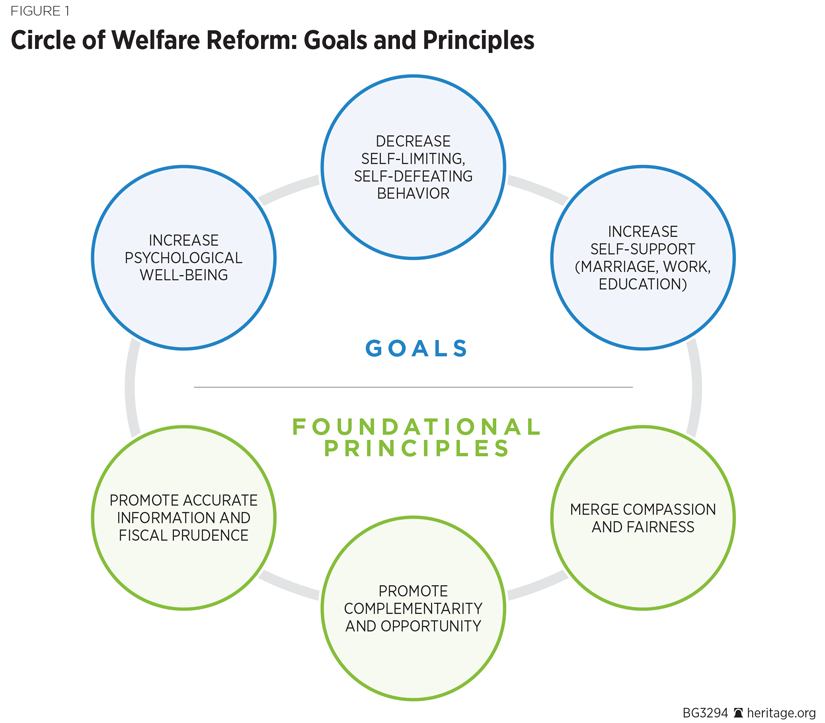
Eleven Policy Initiatives
The foregoing three goals and three foundational principles constitute a permanent framework for sound welfare policy, whether it is implemented in the public sector or in the private sector. These themes can be articulated in 11 concrete initiatives for reforming America’s current means-tested welfare system.
-
Set the proper goals in welfare policy. Current welfare policy is focused largely on increasing cash, food, housing, and medical benefits and on redistributing income. This approach, which has been followed for more than 40 years, has been a failure. In particular, the indifference or outright hostility of the welfare system to marriage in low-income communities has been very damaging.
Welfare policy should be shifted to focus on the triad of new goals: reducing behavioral poverty, improving psychological well-being, and increasing self-support. These three goals are tied together, as behavioral poverty directly harms human well-being and reduces the capacity for self-support. A welfare system oriented around these goals would help rather than harm the poor. Benefits to support living standards should not be cut arbitrarily, but all future assistance should be linked more closely to efforts to foster positive functioning. Policymakers should frame future debates in terms of these new goals.
-
Analyze the welfare system holistically and provide accurate information about welfare spending, typical welfare benefits, poverty, and material living conditions. Press and public discussions of welfare generally analyze welfare in a piecemeal fashion, examining one program at a time in isolation as if the remaining programs did not exist. This is like examining a jigsaw puzzle one piece at a time: The big picture can never be seen. With over 90 programs, the welfare state must be examined holistically, as most recipients typically receive benefits from several programs simultaneously. Material living conditions and behavioral responses are determined by the combined pattern of benefits received, not by single programs in isolation. Discussing or analyzing welfare on a piecemeal basis rather than holistically is inherently misleading and can only lead to irrational policies.
Building an accurate information base is essential to the rational discussion of welfare and poverty issues. Means-tested welfare spending and the combined value of typical welfare benefits are far higher than most imagine. The material living conditions of the poor are much higher and the material deprivation is less frequent than is commonly understood.
Conventional government reports obscure these facts. In particular, the executive branch produces no report on welfare spending or combined benefits, and its annual poverty report excludes welfare almost entirely. This should be changed.
-
Eliminate marriage penalties in the welfare system starting with the EITC. Marriage is the greatest protector against child poverty. Children born to a married mother and father are about 80 percent less likely to be poor compared to children in single-parent homes, according to the official Census poverty measure. Yet more than 40 percent of children in the United States are born outside of marriage annually. Ironically, nearly all means-tested welfare programs impose significant penalties against marriage. If low-income fathers and mothers marry, in most cases, their welfare benefits will be cut and their combined income will fall.
Eliminating all marriage penalties in the welfare system at once would be expensive. The best approach would be to reduce marriage penalties incrementally. The place to start would be eliminating marriage penalties in the EITC.
Additionally, a substantial portion of any future TANF funding must be set aside explicitly to meet the original pro-marriage goals of the legislation by operating pro-marriage programs. For example, PREP for Strong Bonds, a marriage-strengthening program for enlisted men in the Army, has been found in random assignment evaluation to reduce divorces by nearly 50 percent over a two-year period. A share of any future TANF funding should be set aside for programs of this sort.
-
Establish work requirements for able-bodied adults in cash and food programs. Welfare programs should assist those in need, but welfare should not be a one-way handout. Work requirements in welfare promote greater self-support and establish a reciprocal obligation between the beneficiary and the taxpayers who fund the benefits.
Close to 90 percent of Americans agree that “able-bodied adults that receive cash, food, housing, and medical assistance should be required to work or prepare for work as a condition of receiving those government benefits.”REF This viewpoint is nearly identical across party lines: 87 percent of Democrats and 94 percent of Republicans. Work requirements should be introduced or greatly strengthened for three groups: able-bodied, non-elderly adults without dependents receiving food stamps; TANF recipients; and able-bodied parents receiving food stamps.
-
Increase work incentives in the EITC by linking benefits to hours worked. The EITC is superior to other welfare programs because it is the only program that requires recipients to work in order to receive benefits. However, the EITC’s work provisions are flawed. The EITC’s value is tied to annual earnings but is not linked to hours worked during the year. A parent working full-time during the year at the federal minimum wage of $7.25 per hour will receive the same EITC as another parent working half the year at $18.00 per hour. This is inefficient and weakens the program’s intended pro-work incentives. Moreover, there are concerns that the EITC discourages work in its phasedown range because recipients receive less in benefits as they work more.
The EITC payment schedule should be adjusted to reflect both annual earnings and annual hours worked. This would reduce waste and substantially enhance work incentives. To tie the value of the EITC to hours worked, the modified benefit would equal current benefit multiplied by the ratio of actual hours worked to full-time yearly work (2,000 hours). This would dramatically mitigate any work disincentives in the EITC; the more hours a parent worked, the greater his or her EITC benefit would be. It also would greatly reduce any work disincentive in the EITC phasedown range.
This change would reduce overall EITC costs. Savings could be rechanneled to raise the maximum EITC benefit and overall EITC benefit schedule. Low-wage parents working diligently through the year would be substantially better off than they are under the status quo.
-
Limit low-skill immigration. Both legal and illegal immigration bring a disproportionate number of less-skilled workers into the U.S. For example, half of illegal immigrants lack a high school degree. Overall, around 8 million illegal immigrant workers and about 17 million legal immigrant workers are currently in the U.S. About three-quarters of illegal immigrants between 25 and 64 years of age have a high school education or less, and about half (46 percent) of legal immigrants have a high school education or less.
Under current policies, around 5 million lower-skill immigrants with a high school degree or less will enter the U.S. in the next 10 years. These immigrant workers reduce wages for low-skill native workers. Low-skill immigrant labor also displaces low-skill native workers, leading to unemployment and detachment from the labor force.
The decline in employment of lower-skill black workers is particularly troubling. Between 1960 and 2000, the employment rate of black high school dropouts fell catastrophically from 72 percent to 42 percent. Research by prominent Harvard economist George Borjas and others found that an increase in lower-skill immigrant labor led to a substantial drop in wage and employment among similarly skilled blacks and a noted increase in black incarceration.REF Specifically, a 10 percent increase in immigrant labor within a particular skill group led to a 4.0 percentage point drop in wage rates, a 3.5 percentage point drop in employment, and a 0.8 percentage point increase in incarceration among blacks with similar skills. Overall, the surge in low-skill immigration between 1980 and 2000 accounted for 40 percent of the large drop in low-skill employment among blacks without a high school degree during that period. Job loss and lower wages among male workers lead in turn to lower marriage rates, lower upward mobility, and higher child poverty.
Low-skill immigrants also impose heavy fiscal costs directly on U.S. taxpayers. For example, legal immigrants without a high school degree have the highest level of welfare use of any group in the country. The average household headed by a legal immigrant without a high school degree receives nearly four dollars in government benefits for every dollar of taxes paid. Each household, on average, imposes a net cost (total benefits received minus total taxes paid) of nearly $37,000 per year on the taxpayer.
The lower-skill immigrants, both legal and illegal, who will enter the U.S. over the next 10 years will impose a net cost (benefits received minus taxes paid) of $1.9 trillion on U.S. taxpayers.REF Government policy should limit future immigration to those who will be net fiscal contributors who pay more in taxes than they receive in benefits. The legal immigration system should not encourage immigration of low-skill immigrants who would increase poverty in the nation and impose vast new costs on already overburdened taxpayers. To save taxpayer cost and to reduce child poverty in the U.S., the number of low-skill immigrants who enter the country, either legally or illegally, and compete with less skilled American workers should be strictly limited.
-
Create and sustain jobs for lower-skill workers. Policies like increasing the minimum wage that will reduce employment opportunities for the least skilled workers should be avoided. As noted throughout this paper, once welfare benefits are counted, parents working full-time at the current federal minimum wage have combined incomes from earnings and benefits that are nearly twice the poverty income level.
Ensuring that low-wage parents who work full-time are not poor is a reasonable objective; however, given the current system of benefits, it is not necessary to raise the minimum wage to meet that objective. In reality, raising the minimum wage would actually push many families deeper into poverty by destroying the jobs they need to climb above the poverty level.REF When the government arbitrarily raises the wages of low-skill workers, businesses will hire fewer such workers. The job-loss effects from an increase in the minimum wage will focus on the most vulnerable within the low-skill group, such as single mothers without a high school degree.
A sensible course would be to create greater employment opportunities for hard-to-employ individuals in low-income neighborhoods through transitional jobs and wage subsidies. Some low-skill individuals, such as former prison inmates, may have a particularly difficult time obtaining employment. Employment opportunities for these hard-to-employ workers may be expanded by reforming programs such as the Work Opportunity Tax Credit (WOTC) to provide strong wage subsidies for groups that experience the greatest difficulty obtaining employment.
-
Increase program effectiveness by creating outcome-based funding rather than service-based funding. Around a tenth of means-tested spending goes to programs aimed at improving individual capacities or altering behavior in a positive manner: for example, by reducing drug abuse, prison recidivism, or school failure. Decades of research has shown that most of these programs are ineffective or produce small changes at large costs. This record of ineffectiveness is well-known within the social science community as “Rossi’s law,” after noted researcher Peter H. Rossi, who famously asserted with respect to behavior change programs that “[t]he expected value of any net impact assessment of any large scale social program is zero…. The better designed the impact assessment [i.e., evaluation], the more likely is the resulting estimate of net impact to be zero.”REF
A new approach is needed to overcome Rossi’s law. Programs seeking to change behavior should be restructured to link funding to positive outcomes achieved rather than merely to services provided, and mechanisms should be established to shift funds automatically from ineffective to effective service providers. A good place to start would be with drug treatment programs.
-
Eliminate waste, fraud, abuse, and excessive benefits in the welfare system. Another problem is that current welfare spending is simply wasteful, with funds going to fraudulent, erroneous, and excessive payments or to ineffective programs. Each year, for example, nearly $30 billion in fraudulent, erroneous, and wasteful spending in cash grants is distributed by the Earned Income Tax Credit and Additional Child Tax Credit programs.REF Extensive waste occurs in other programs as well.
Policymakers should identify and eliminate wasteful spending. A portion of the savings derived from eliminating waste should be rechanneled to effective initiatives to help the poor that are designed in accordance with the preceding themes. The remaining savings should go to badly needed deficit reduction. Reforming never means arbitrarily chopping spending. Spending must be reprioritized, waste must be eliminated, and incentives must be changed to make programs more humane and effective.
-
Renew authentic federalism by requiring states to bear a greater share of the fiscal cost of the welfare state. Close to 74 percent of the $1.1 trillion in current government spending on means-tested welfare comes from the federal government. Moreover, nearly all state spending is focused on a single program: Medicaid. A related problem is that welfare programs are funded primarily by the federal government but administered by state governments.
This is a recipe for inefficiency and waste. Historical experience shows that state governments spend their own revenues more frugally than they spend “free” money from Washington. The federal government currently pays for about 90 percent of the cost of cash, food, and housing benefits for the poor; state and local governments should pay an increased share.
-
Avoid ineffective and counterproductive policies: block granting, reducing marginal tax rates in welfare, and program consolidation. Discussions of welfare reform often entertain a number of ineffective and counterproductive policies. One frequently discussed welfare reform idea is program consolidation: combining a number of small programs into a larger single program. It is often assumed that program consolidation will reduce costs by reducing administrative overhead, but the overhead costs in welfare are typically less than 10 percent; therefore, it is not likely that consolidation will substantially reduce spending. The real problem in welfare is the incentive structures of welfare programs themselves, not the administrative portion of funding in a program or the number of programs overall. Consolidating five small ineffective programs that discourage self-sufficiency will simply produce one medium-size program that discourages self-sufficiency.
The key to reform is to change the content and character of welfare programs, not merely to reduce their number. Historical experience with welfare program consolidation in the 1980s and 1990s shows that it did not actually alter policies and operations. Program consolidation consumes policymakers’ time, energy, and political capital while producing the appearance of change rather than real reform.
Another commonly discussed welfare reform idea is block granting. In a block grant, tax revenue is collected at the federal level in Washington and handed over to the state governments to spend as they will. Block granting is described as “federalism,” but it is in fact “faux federalism.” Real federalism would involve state governments designing and operating their own welfare programs and funding those programs with state tax revenues. Collecting tax revenues at one level of government and then spending those revenues at another level is not federalism at all; instead, it is a recipe for inefficiency, lack of accountability, and waste. While converting the funding structure of a program from open-ended entitlement to a fixed discretionary sum can reduce costs in the long term, it is not a meaningful mechanism for transforming welfare.
In fact, welfare and social services block grants have a long history of failure stretching back to the Administration of Richard Nixon. For example, President Reagan created a number of welfare block grants in the 1980’s.REF Despite $667 billion in spending, these block grants have never served as vehicles of reform; instead, fiscal conservatives almost universally regard them as exemplars of wasteful and inefficient spending.REF
Temporary Assistance for Needy Families, created in 1996, is often cited as a successful “block grant.” In reality, TANF did the opposite of what is typically meant by this statement: It placed clear new rules on state governments by requiring them for the first time to have a portion of welfare recipients engage in work.REF In the long term, it pushed states to rely on their own tax revenues rather than federal revenue. TANF was therefore a model of policy initiatives 4 and 10 rather than the idea that state governments should be free to spend federal revenue as they chose.REF
A final misplaced idea is to increase work by reducing so-called marginal tax rates or benefit cliffs in welfare.REF In reality, the benefit reduction rates for most single mothers are close to zero until earnings reach around $20,000 per year and combined benefits and earnings approach $40,000 per year.REF Multiple controlled random assignment experiments consistently show that reducing benefit reduction rates does not increase work.REF However, reducing benefit reduction rates does substantially increase welfare costs and dependence. By contrast, work requirements in welfare increase work while decreasing costs and dependence.
Conclusion
The means-tested welfare system consists of the total spending on cash, food, housing, medical care, and social services in programs targeted toward poor and near-poor persons. The federal government runs 89 separate means-tested aid programs. In FY 2016, federal, state, and local government spent $1.1 trillion on means-tested aid. (Social Security and Medicare are not part of the means-tested welfare system and are not included in this spending total.)
Of the $1.1 trillion spent in FY 2016, federal expenditures accounted for three-quarters, and state expenditures accounted for the remaining quarter. Moreover, most state spending occurs in a single program: Medicaid. If Medicaid is excluded from the spending count, federal funds account for about 85 percent of the remaining means-tested expenditures.
Medical care absorbed almost 60 percent of total means-tested spending, while cash, food, and housing comprised 31 percent. Altogether, cash, food, housing, and medical care comprised nine-tenths of total welfare costs. The remaining means-tested spending (job training, social services, child development and child care, targeted education, and community development) took up only 9.3 percent of total means-tested spending.
Families with children received slightly more than half of the $1.1 trillion in total spending. Some 40 percent went to elderly and disabled persons. The remaining 9 percent went to able-bodied adults who were neither parents nor elderly.
Adjusted for inflation, welfare spending has increased more than twelvefold since the start of the War on Poverty in 1964: from $91.9 billion in 1964 to over $1.1 trillion in 2016 in constant 2016 dollars. Total inflation-adjusted welfare spending per person increased more than sevenfold over the same period. When Lyndon Johnson inaugurated the War on Poverty in 1964, means-tested spending was 1.5 percent of GDP.REFBy 2016, means-tested welfare had risen to over 6 percent of GDP.
The financial cost of the War on Poverty has been enormous. Between 1965 and 2016, total means-tested welfare spending by federal and state governments cost taxpayers roughly $27.8 trillion in constant 2016 dollars. By contrast, the cost to the U.S. government for all military wars from the American Revolution to the present is $8 trillion in FY 2016 dollars.
Means-tested cash, food, and housing spending for families with children is about three times the amount needed to eliminate all poverty within that group. If medical care for families with children is added, total spending is nearly six times the amount needed to eliminate all poverty in that group.
One may reasonably ask how government can spend so much on welfare and still have great inequality and so many people living in apparent poverty. The answer is that the Census Bureau ignores nearly the entire welfare system in its income measurements. In its conventional poverty reports, the Census Bureau counts only 5 percent of total welfare spending as income. Most government discussions of poverty and inequality simply ignore the massive transfers of the existing welfare state and thus are highly misleading.
Debates about welfare in the U.S. often degenerate into a fiscal tug of war in which the left simply seeks to expand conventional welfare spending while the right seeks to shrink it. It is true that the welfare system is far larger and costlier than the public imagines. There is extensive waste and fraud throughout the system. But the most important problem in welfare is not its considerable cost to the taxpayers but its harmful effects on the poor themselves. The current welfare system undermines self-sufficiency and pushes individuals toward the margins of society. It undermines work and attacks marriage, and by so doing, it strikes at the roots of human happiness and well-being. Therefore, the principal goal of welfare reform should not be merely to cut spending. Instead, the goals and content of welfare programs must be transformed so that they truly benefit the poor.
There are three key reform policies to achieve this transformation. First, able-bodied non-elderly adults who receive most means-tested aid should be required to work or prepare for work as a condition of receiving assistance. Second, the penalties against marriage that are embedded in the welfare system should be sharply reduced or eliminated. Finally, programs that are intended to improve behavior or human capacity (such as drug treatment and prison anti-recidivism programs) should be shifted from the current payment-of-service mode to a payment-for-outcome structure.
—Robert Rector is Senior Research Fellow in Domestic Policy Studies, of the Institute for Family, Community, and Opportunity, at The Heritage Foundation. Vijay Menon is a Graduate Fellow in Welfare Policy in Domestic Policy Studies, of the Institute for Family, Community, and Opportunity, at The Heritage Foundation.
Appendix A
What Is Means-tested Welfare or Aid to the Poor?
Government welfare programs differ from most other government activities. While most government programs provide benefits and services across all citizens irrespective of economic class, welfare programs provide benefits exclusively to persons with lower incomes. Government welfare programs provide assistance to less-affluent persons that is not available to the general populace because lower-income persons have greater difficulty supporting themselves.
Therefore, the U.S. welfare system may be defined as the total set of federal and state government programs that are designed specifically to assist poor and low-income Americans. Accordingly, a government program is a “welfare” program if it provides assistance or benefits exclusively and deliberately to poor and low-income persons. A very small number of programs provide assistance targeted to low-income communities rather than individuals. Those who object to the term “means-tested welfare” may refer to the system as comprehensive “aid to poor and low-income persons.”
Distinguishing Between Means-Tested Welfare and Other Safety Net Programs
Means-tested welfare programs can be considered part of a larger government safety net that includes five components:
-
Means-tested welfare benefits;
-
Retirement benefits and medical care for the elderly through Social Security and Medicare;
-
Benefits for disabled workers through Social Security Disability Insurance and Medicare;
-
Temporary income for unemployed workers through unemployment insurance; and
-
Income and medical benefits for workers injured on the job, which are provided through the workers’ compensation program.
The last four components of the safety net differ sharply from means-tested welfare. It is true that unemployment insurance, Social Security Disability Insurance, and workers’ compensation resemble means-tested programs in one respect: Because they are intended to replace wages lost through injury or involuntary unemployment, they are available only to persons with limited earned incomes. However, these safety net programs have other characteristics that clearly distinguish them from typical means-tested welfare programs.
Unlike means-tested welfare programs, the other safety net programs, including Social Security retirement and Medicare, are based on earned eligibility; require financial contributions from potential beneficiaries; have no limitations on assets, property income, or the income of other family members; generally provide higher benefits to higher-income workers; are not need-based; and offer almost universal eligibility to members of the working population and their dependents.
Welfare programs do not have earned eligibility. Social Security, Medicare, Disability Insurance, unemployment insurance, and workers’ compensation are based on earned eligibility. To become eligible for benefits, individuals must have maintained employment for an extended period. By contrast, with means-tested programs, there is no expectation that the beneficiary is to earn eligibility for the program.
Although many recipients of means-tested welfare do work, means-tested programs do not require that individuals have an extended work history in order to qualify for benefits.REF Many individuals receive benefits from such means-tested programs as Supplemental Security Income or Medicaid precisely because they have not earned eligibility for such broader safety net programs as Social Security or Medicare.
Welfare programs do not require financial contributions. To become eligible for benefits in non-means-tested programs, individuals not only must maintain employment for an extended period, but also must pay financial contributions into the program. In most cases, recipients are regarded as having earned the right to benefits by making prior financial contributions to the system, although the value of the contributions paid will often be less than the benefits received.
In the unemployment insurance and workers’ compensation systems, benefits are financed by fees paid by employers, but employers finance those fees in part by paying lower wages to employees. By contrast, with means-tested programs, there is no expectation that the beneficiary will have earned eligibility or made any payments to finance the program. Instead, means-tested programs are financed overwhelmingly by the taxes paid by higher-income families that are unlikely to receive benefits.
Welfare programs restrict eligibility according to assets, property income, or the income of other family members. Most means-tested welfare programs limit eligibility to households without significant assets or property income. In addition, eligibility is usually based on the family’s entire income, so high earnings by one family member will generally preclude the others from receiving welfare benefits.
By contrast, non-means-tested safety net programs generally do not restrict eligibility because of assets, property income, or the income of other family members. For example, the ongoing wages of one spouse would not prevent the other spouse from receiving unemployment insurance if the second spouse lost a job. Limits on assets and property income often preclude middle-class families from receiving means-tested welfare aid even when the family experiences a sharp temporary drop in earnings. The absence of such limits in non-means-tested safety net programs means that nearly all upper-middle-class and wealthy individuals are potentially eligible to participate in them.
The practical effect of asset limits can be seen in the differences between unemployment insurance and food stamps. Families receiving food stamps typically cannot have more than $2,000 in liquid assets, but there are no asset limits on eligibility for unemployment insurance. When the main wage earner in a lower-income family loses a job, the family will typically receive both unemployment insurance and food stamps. However, when the same event happens in an upper-middle-class family, the asset rule will generally block the family from receiving food stamps. An upper-middle-class family with an unemployed wage earner will therefore typically receive unemployment insurance but not food stamps.
Welfare programs do not provide higher benefits to higher-wage workers. Social Security, unemployment insurance, and workers’ compensation are earned-eligibility programs funded by employee and employer contributions. In Social Security, higher-wage workers pay higher taxes to support the program and subsequently receive somewhat higher benefits as retirees. In the unemployment insurance and workers’ compensation programs, it is unclear whether higher fees are paid by employers for higher-wage workers; nonetheless, higher-wage workers do receive higher benefits. This is the exact opposite of means-tested welfare programs in which the poorest family generally receives the highest benefits.REF
Welfare programs do not have nearly universal eligibility. Well over 90 percent of all workers are potentially covered by Social Security, Medicare, unemployment insurance, and workers’ compensation. As noted, these individuals pay fees or tax contributions to support the programs, or their employers pay fees and taxes on their behalf. The absence of asset and property income limits on eligibility means that nearly all workers who make tax contributions to these programs (including wealthy workers) eventually become eligible as beneficiaries.
Thus, nearly all of the normal working population in the U.S. and their dependents are potential beneficiaries of these programs. This is in distinct contrast to means-tested aid programs, which typically subsidize only the one-fourth or one-third of the population with the lowest incomes.
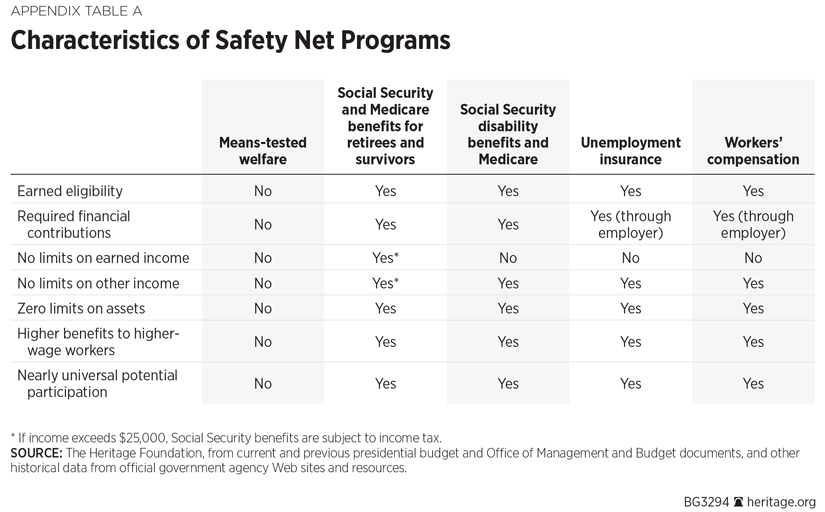
Are Education, Development, and Training Programs Really Welfare?
Some object to counting capacity-building programs such as Job Corps, Head Start, and Pell Grants as welfare. They regard welfare as pertaining to programs for persons who do not work; therefore, they see education, development, and training programs that are designed to increase employment and earnings as the opposite of welfare.
On the other hand, these programs are clearly designed to aid the poor. They are means-tested. Through them, government provides benefits and assistance to lower-income persons that it does not provide (or provides less generously) to higher-income persons. It would be hard to argue that such programs are not aid to the poor in a broad sense of that term. Interestingly, child development, job training, and targeted educational assistance all played critical roles in the early stages of the War on Poverty.
If the objective is to count all taxpayer funds deliberately spent on behalf of poor and lower-income persons, then means-tested services such as job training, child development, community aid, social services, and targeted education aid clearly must be counted. However, in the final analysis, it does not matter much whether capacity-building programs such as Job Corps, Head Start, and Pell Grants are counted as welfare because spending on this type of means-tested aid is limited.
As noted, over nine-tenths of means-tested spending falls under the four core functions of cash, food, housing, and medical care. The remaining five functions (job training, child development, community aid, social services, and targeted education aid) comprise only 9.8 percent of total welfare spending. Thus, inclusion or exclusion of these five types of means-tested aid from the definition of welfare has only a marginal impact on any of the total spending figures presented in this paper.
Should the Term “Welfare” Refer Only to Cash Programs?
More extreme advocates argue that only means-tested cash aid programs should be counted as welfare.REF This excludes over 80 percent of the benefits and assistance that taxpayers provide to low-income persons and communities. The “cash only” definition of welfare ignores nearly all of the aid to the poor that is actually provided by the government. It is easy in this manner to become trapped in the faulty circular “logic” of trying to prove that the government spends little on the poor by not counting most of what is actually spent.REF
Means-tested programs that provide cash, food, housing, and medical care differ in their external forms, but they share common fundamental characteristics.
-
All of the programs serve similar overlapping populations that generally fall within the one-third of the U.S. population with the lowest incomes.
-
All of the programs have one common purpose: They seek to improve the material living conditions and physical well-being of lower-income persons by increasing the de facto purchasing power or economic resources of those individuals, thereby enabling them to purchase or obtain goods or services that they cannot obtain on their own.
-
Each program seeks to increase the de facto purchasing power or economic resources of individuals by one of three mechanisms:
-
Providing cash that can be used to purchase goods and services (e.g., TANF, EITC, and SSI);
-
Providing vouchers that can be used to purchase specified goods and services (e.g., food stamps, WIC coupons, and housing vouchers);
-
or Directly subsidizing the providers of benefits or services, thereby enabling the beneficiary to obtain them at little or no cost (e.g., Medicaid services, public housing, and the school lunch program).
-
-
All of the programs are deliberately redistributive: Economic resources are taken from the upper middle class and reallocated with the goal of raising the living standards of the less affluent.
Seen in this light, it does not particularly matter whether a program provides cash, food, housing, or medical care. All of the programs have a common purpose; it matters little if a program offers a poor person cash, coupons, or a debit card to buy food.
Similarly, it makes little difference whether the government gives a needy individual cash to pay rent or provides subsidies to public housing authorities that are used to reduce the rental payments required of low-income tenants. From the perspective of the taxpayer and governmental budgets, what matters is the cost of providing a benefit to the poor, not the specific mode that the benefit takes.
Appendix B: Methodology
Data Sources
A wide variety of government documents were used in compiling the spending figures in this paper. These information sources include:
-
Committee on Ways and Means, U.S. House of Representatives, Green Book: Background Material and Data on Programs Within the Jurisdiction of the Committee on Ways and Means, 103rd Cong., 1994, https://greenbook-waysandmeans.house.gov/1994-green-book (accessed March 1, 2018).
-
Karen Spar, “Cash and Noncash Benefits for Persons with Limited Income: Eligibility Rules, Recipient and Expenditure Data, FY2002–FY2004,” Congressional Research Service Report for Congress, March 27, 2006, http://file.wikileaks.org/file/crs/RL33340.pdf (accessed March 1, 2018), and earlier editions, 1976 to 2005.
-
U.S. Office of Management and Budget, Budget of the United States Government (Washington: U.S. Government Printing Office, various years), https://www.whitehouse.gov/omb/budget/ (accessed March 1, 2018).
-
U.S. Office of Management and Budget, Budget of the United States Government: Historical Tables (Washington: U.S. Government Printing Office, various years), https://www.whitehouse.gov/omb/budget/Historicals (accessed June 2, 2016).
-
Peter Germanis and Richard Bavier, eds., Up from Dependency: A New National Public Policy Assistance Strategy, Supplement 1: The National Public Assistance System, Vol. 2: A Compendium of Public Assistance Programs: Major Cash, Food, and Housing Programs, Executive Office of the President, Interagency Low-Income Opportunity Advisory Board, September 1987, http://eric.ed.gov/?id=ED316589 (accessed June 10, 2016).
-
Ida C. Merriam and Alfred M. Skolnik, Social Welfare Expenditures Under Public Programs in the United States, 1929–66, Social Security Administration, Office of Research and Statistics Research Report No. 25, 1968.
-
Social Security Administration, Social Security Bulletin, various issues, https://www.ssa.gov/policy/docs/ssb/index.html (accessed November 15, 2016).
Inflation Adjustments for Means-Tested Expenditures Prior to FY 2016
In this paper, means-tested expenditures in prior periods are often compared to current spending levels. To make these comparisons more meaningful, historic spending amounts are generally adjusted for inflation into constant 2016 dollars.
However, means-tested welfare is disproportionately comprised of medical spending, and medical costs have risen more rapidly than other consumer prices. Because of this, adjusting total welfare expenditures for inflation with a broad price index, such as the Consumer Price Index (CPI), would tend to understate the role of inflation in welfare costs and to overstate the real growth of welfare spending.
To correct for this problem, whenever historical means-tested expenditures are adjusted for inflation in this paper, separate inflationary adjustments have been made for medical assistance, food assistance, and housing assistance using the appropriate price index for each spending category. Unless otherwise noted, all inflation adjustments of historical welfare spending figures used the personal consumption expenditure price indices provided in the National Income and Product Accounts of the Bureau of Economic Analysis at the U.S. Department of Commerce. Specifically:
-
Means-tested expenditures on medical care were adjusted by the personal consumption expenditure price index for medical care.
-
Means-tested expenditures for food assistance were adjusted by the personal consumption expenditure price index for food.
-
Means-tested expenditures for housing aid were adjusted by the personal consumption expenditure price index for housing.
-
All other means-tested expenditures were adjusted by the personal consumption expenditure price index for all goods and services.
